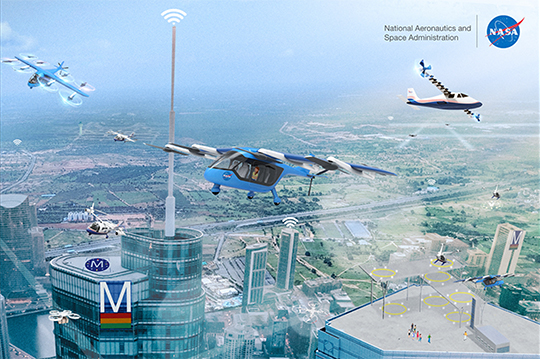|
|
 |

|
 |
 |
The High Density Vertiplex (HDV) subproject is responsible for the development and evaluation of a reference automation architecture that addresses scalable and efficient aircraft operations, flight and airspace management procedures, and vertiport operations in high density vertiplex environments.
HDV is a sub-project of the Advanced Air Mobility (AAM) project under the Integrated Aviation Systems Program (IASP).
What is a Vertiplex?
A Vertiplex is a geographic area that includes multiple vertiports whose arrival and departure operations are highly interdependent.
Purpose and Research Approach
The purpose of this research is to design concepts, procedures, and technologies focused on Urban Air Mobility (UAM) operations in a vertiplex environment. The HDV approach will be to gradually build-up complexity in the operational environment through a series of tests. Testing will be performed subscale using small Unmanned Aerial Systems (sUAS) as surrogates for UAM aircraft. Testing cycles will start out fully simulated, then culminate in live flight tests with small UAS at Langley Research Center. Results from each testing cycle will be used to support subsequent risk assessments. The overall goal is to create a representative UAM system to mitigate risk for future research and development.
Concepts Being Explored
Aircraft-airspace-vertiport automation technology must be integrated and matured to support three main use cases: (1) automated landing, (2) automated merging and spacing, and (3) automated contingency decision making.
Role of the AOL in HDV
During simulations and flights tests, the Airspace Operations Laboratory (AOL) and the Autonomous Vehicle Applications Laboratory (AVAL) will serve as the base of operations for Airspace Systems Integration (ASI), which integrates systems and software from Unmanned Aerial Systems (UAS) Traffic Management (UTM) to support HDV concepts. Some of the outcomes of this work include prototype airspace management automation technology and human factors evaluation.
Joining the AOL in the HDV flight testing efforts are the Autonomous Vehicle Applications Laboratory (AVAL) from the NASA Ames' Human Systems Integration Division, and the Air Traffic Operations Laboratory (ATOL) from Langley Research Center.

Illustration of Urban Air Mobility (UAM) Operations in a High Density Vertiplex (HDV) environment
Point of Contact: Gita Hodell, M.A., Human Systems Integration Division, NASA Ames Research Center |
|
|